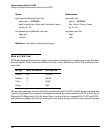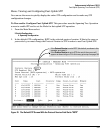
148
Enhancements in Release F.02.11
Fast-Uplink Spanning Tree Protocol (STP)
Enhancements in Release F.02.11
Fast-Uplink Spanning Tree Protocol (STP)
Fast-Uplink STP improves the recovery (convergence) time in wiring closet switches with redundant
uplinks. Specifically, a Series 2500 switch having redundant links toward the root device can decrease
the convergence time (or failover) to a new uplink (STP root) port to as little as ten seconds. To
realize this performance, a Series 2500 switch must be:
■ Used as a wiring closet switch (also termed an edge switch or a leaf switch).
■ Configured for fast-uplink STP mode on two or more ports intended for redundancy in the
direction of the root switch, so that at any time only one of the redundant ports is expected
to be in the forwarding state.
Note
When properly implemented, fast-uplink STP offers a method for achieving faster failover times than
standard STP. While fast-uplink STP remains an effective means for reducing failover time, HP
recommends that you move to the Rapid Convergence STP (RSTP; 802.1w) available with software
release F.04.08 and greater, for the best failover performance.
Caution
In general, fast-uplink spanning tree on the Series 2500 switches is useful when running STP in a
tiered topology that has well-defined edge switches. Also, ensure that an interior switch is used for
the root switch and for any logical backup root switches. You can accomplish this by using the
Spanning Tree Priority (sometimes termed bridge priority) settings that define the primary STP root
switch and at least one failover root switch (in the event that the primary root switch fails).
Inappropriate use of Fast-Uplink STP can cause intermittent loops in a network topology. For this
reason, the Fast-Uplink STP feature should be used only by experienced network administrators who
have a strong understanding of the IEEE 802.1D standard and STP interactions and operation. If you
want to learn more about STP operation, you may find it helpful to refer to publications such as:
Perlman, Radia, Interconnections, Second Edition; Bridges, Routers, Switches, and Internet-
working Protocols, Addison-Wesley Professional Computing Series, October 1999
Enhancement Summary Page
Adds the fast-uplink span-
ning tree (STP) mode to
spanning-tree operation
In an 802.1D STP environment with redundant links, an active link failure typically
results in a convergence time of 30 seconds for a backup link to become the active,
forwarding link. Fast-uplink STP reduces this time to approximately ten seconds.
below
Adds the show tech
command to the switch
troubleshooting capabilities
This command outputs, in a single listing, switch operating and running configura-
tion details from several internal switch sources.
162


















